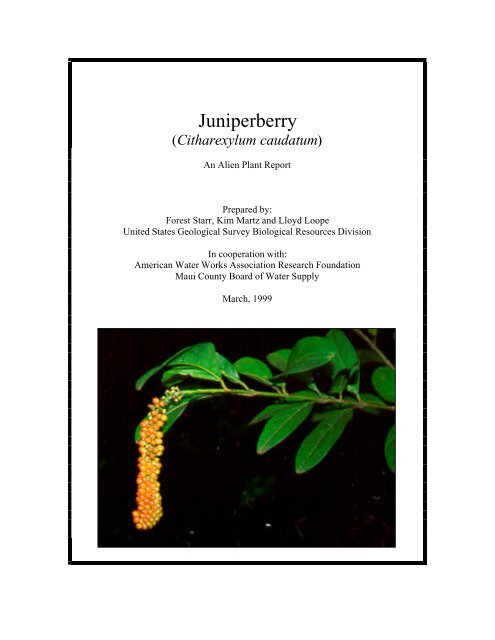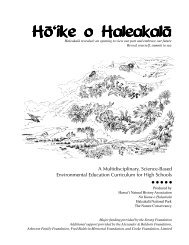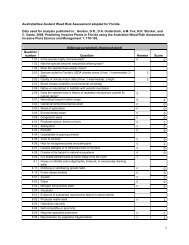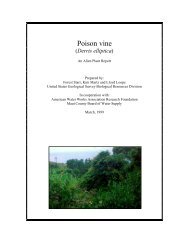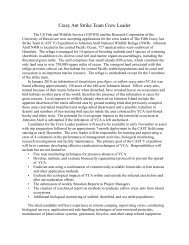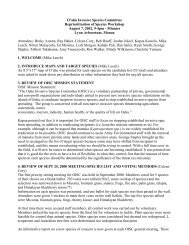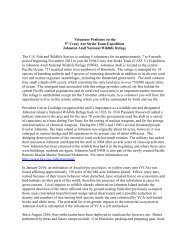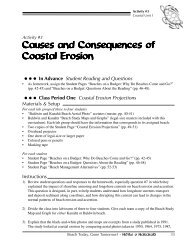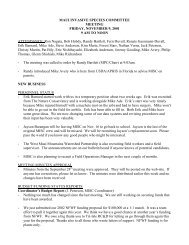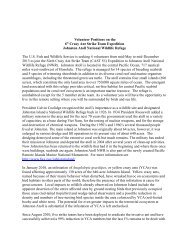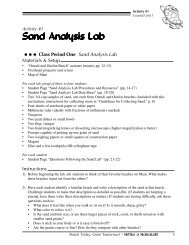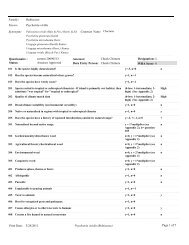(Citharexylum spinosum): an alien plant report - Hawaiian ...
(Citharexylum spinosum): an alien plant report - Hawaiian ...
(Citharexylum spinosum): an alien plant report - Hawaiian ...
You also want an ePaper? Increase the reach of your titles
YUMPU automatically turns print PDFs into web optimized ePapers that Google loves.
Juniperberry<br />
(<strong>Citharexylum</strong> caudatum)<br />
An Alien Pl<strong>an</strong>t Report<br />
Prepared by:<br />
Forest Starr, Kim Martz <strong>an</strong>d Lloyd Loope<br />
United States Geological Survey Biological Resources Division<br />
In cooperation with:<br />
Americ<strong>an</strong> Water Works Association Research Foundation<br />
Maui County Board of Water Supply<br />
March, 1999
Juniperberry<br />
(<strong>Citharexylum</strong> caudatum)<br />
What is Juniperberry? Why is it bad?<br />
Juniperberry is a fast growing tree that forms a dense c<strong>an</strong>opy, <strong>an</strong>d smothers vegetation. It<br />
is distinguished by its bright or<strong>an</strong>ge leaves <strong>an</strong>d or<strong>an</strong>ge berries. On O’ahu, juniperberry<br />
achieves higher densities th<strong>an</strong> strawberry guava. On Maui, juniperberry is currently only<br />
known from Ohia gulch in Ha’iku, <strong>an</strong>d on the way to H<strong>an</strong>a near Kolea stream.<br />
What should you do if you see this pl<strong>an</strong>t?<br />
1. Call the Hawaii Ecosystems at Risk (HEAR) project at 572-4418.<br />
2. Pull out the tree, if possible. Otherwise, cut the tree near the root of the pl<strong>an</strong>t, <strong>an</strong>d<br />
treat with <strong>an</strong> herbicide in accord<strong>an</strong>ce with label.<br />
3. For more information, or additional copies of this poster, call 572-4418, or websurf to<br />
www.hear.org.<br />
You c<strong>an</strong> help keep Maui no ka oi.<br />
United States Geological Survey<br />
Maui County<br />
Biological Resources Division<br />
Board of Water Supply<br />
Juniperberry (<strong>Citharexylum</strong> caudatum) 2<br />
Americ<strong>an</strong> Water Works Association<br />
Research Foundation
Juniperberry<br />
(<strong>Citharexylum</strong> caudatum)<br />
Overview: Juniperberry was known to be a problem weed on O'ahu, but was previously<br />
thought to be absent on Maui. In preparing for this <strong>report</strong>, the authors learned what to<br />
look for, <strong>an</strong>d as is becoming increasingly apparent, it was only a matter of time before<br />
juniperberry turned up. Juniperberry was found in both Ha'iku <strong>an</strong>d near Kolea stream on<br />
the way to H<strong>an</strong>a. In both places, it is well established <strong>an</strong>d would be difficult, if not<br />
impossible, to eradicate.<br />
Public involvement potential: Juniperberry is probably beyond the eradication stage,<br />
but it provides <strong>an</strong> example of how pl<strong>an</strong>ts c<strong>an</strong> go undetected for m<strong>an</strong>y years <strong>an</strong>d<br />
emphasizes that a list of all the pl<strong>an</strong>ts on Maui is needed. The public c<strong>an</strong> help by<br />
<strong>report</strong>ing <strong>an</strong>y new locations of juniperberry, especially in the watershed.<br />
Common Name: Juniperberry, fiddlewood.<br />
Latin Name: <strong>Citharexylum</strong> caudatum L.<br />
Taxonomy: <strong>Citharexylum</strong> is a genus of over 70 species from Bermuda, the West Indies,<br />
<strong>an</strong>d southern United States through Mexico to South America. The generic name<br />
<strong>Citharexylum</strong> is Greek for fiddlewood. The English name fiddlewood <strong>an</strong>d similar ones in<br />
French <strong>an</strong>d Sp<strong>an</strong>ish for related species apparently were taken from the scientific name<br />
without regard to actual use of the wood.<br />
Description: Large shrubs or small trees up to 20 m tall; br<strong>an</strong>ches nearly terete,<br />
glabrous. Leaves somewhat leathery, oblong to obovate or elliptic-obl<strong>an</strong>ceolate, 7-16 cm<br />
long, 3.5-5 cm wide, glabrous, upper surface glossy, lower surface dull, apex rounded or<br />
obtuse, base connate, petioles green, 1-2 cm long. Flowers in narrow, elongate-recurved<br />
racemes 4-10 cm long, pedicels usually 2-5 mm long; calyx camp<strong>an</strong>ulate, ca. 3 mm long,<br />
the rim unlobed <strong>an</strong>d truncate in fruit; corolla white. Fruit purplish black, oblong-globose,<br />
ca. 5-8 mm long (Wagner et al. 1990).<br />
Noxious Weed Acts: <strong>Citharexylum</strong> caudatum is not on the Hawai’i state noxious weed<br />
list.<br />
Native R<strong>an</strong>ge: Native from Mexico <strong>an</strong>d Central America to northern South America <strong>an</strong>d<br />
the West Indies (Wagner et al. 1990).<br />
R<strong>an</strong>ge of Invasion: Juniperberry is invading on O'ahu <strong>an</strong>d Maui, where it forms dense<br />
thickets in wet habitats. On O'ahu, it is spreading out of M<strong>an</strong>oa Valley into the Ko’olau<br />
Mountains (Wagner et al. 1990). On Maui, it c<strong>an</strong> be found in 'Ohia gulch <strong>an</strong>d along west<br />
Kuiaha road in Ha'iku. It appears as if a pl<strong>an</strong>ting of both C. caudatum <strong>an</strong>d C. <strong>spinosum</strong><br />
escaped the confines of the garden <strong>an</strong>d spread in all directions along roadsides, into<br />
Juniperberry (<strong>Citharexylum</strong> caudatum) 3
pastures, <strong>an</strong>d into nearby gulches. Near Kolea stream on the way to H<strong>an</strong>a, juniperberry<br />
c<strong>an</strong> be seen at the wayside <strong>an</strong>d in nearby roadsides, pastures, <strong>an</strong>d gulches.<br />
Value to hum<strong>an</strong>s: Nice specimen tree whose leaves turn or<strong>an</strong>ge <strong>an</strong>d give the appear<strong>an</strong>ce<br />
of fall colors. The light brown wood is used elsewhere for posts, not for musical<br />
instruments. This species is a honey pl<strong>an</strong>t (Little 1989).<br />
Problems: In Hawai’i cultivated <strong>an</strong>d now naturalized <strong>an</strong>d rapidly spreading via bird<br />
dispersal out of M<strong>an</strong>oa Valley into the Ko’olau Mountains.<br />
Biology <strong>an</strong>d Ecology: The coffee twig borer c<strong>an</strong> be found in young shoots on O'ahu (P.<br />
Welton pers. comm. 1998). Juniperberry produces m<strong>an</strong>y seeds which c<strong>an</strong> germinate in<br />
very dark situations. It c<strong>an</strong> even germinate on steep rock faces. Juniperberry is also<br />
capable of rooting at the nodes if a stem is pinned to the ground. It has m<strong>an</strong>y<br />
characteristics in common with C. <strong>spinosum</strong>. First introduced to the Hawaii<strong>an</strong> Sugar<br />
Pl<strong>an</strong>ters’ Association Arboretum (now Harold L. Lyon Arboretum) in M<strong>an</strong>oa Valley<br />
from seed obtained by E. L. Caum in 1931 (Wagner et al. 1990).<br />
Physical control: Seedlings <strong>an</strong>d small pl<strong>an</strong>ts c<strong>an</strong> be pulled up by h<strong>an</strong>d.<br />
Chemical control: Little is known about chemical control methods for juniperberry, but<br />
herbicides will undoubtedly be a part of <strong>an</strong>y control strategy for fiddlewood.<br />
M<strong>an</strong>agement recommendations: Field crews <strong>an</strong>d the public should familiarize<br />
themselves with juniperberry <strong>an</strong>d <strong>report</strong> new locations to USGS-BRD-MAUI. New<br />
locations should be locally controlled if possible. A list of all pl<strong>an</strong>ts on Maui should be<br />
compiled, <strong>an</strong>d const<strong>an</strong>tly updated to find pl<strong>an</strong>ts like juniperberry before they become<br />
established <strong>an</strong>d begin to spread.<br />
Key contacts:<br />
Forest Starr & Kim Martz<br />
United States Geological Survey – Biological Resources Division<br />
PO Box 369<br />
Makawao, HI 96768<br />
(808) 572-4472<br />
Bob Hobdy<br />
Hawai’i State Department of L<strong>an</strong>d <strong>an</strong>d Natural Resources -- Division of Forestry <strong>an</strong>d<br />
Wildlife<br />
54 S. High St. Rm. 101<br />
Wailuku, HI 96793<br />
(808) 984-8100<br />
Literature cited & references:<br />
Haselwood, E. L. 1983. H<strong>an</strong>dbook of Hawaii<strong>an</strong> Weeds, second edition. University of<br />
Hawai'i Press, Honolulu, Hawai'i.<br />
Juniperberry (<strong>Citharexylum</strong> caudatum) 4
Little E. L. Jr. <strong>an</strong>d R. G. Skolmen. 1989. Common forest trees of Hawai'i (native <strong>an</strong>d<br />
introduced). United States Department of Agriculture.<br />
Turner, R. J. Jr. <strong>an</strong>d E. Wasson. 1997. Bot<strong>an</strong>ica. Mynah Publishing. NSW Australia.<br />
1007 pp.<br />
Wagner, W. H., D. R, Herbst, S. H. Sohmer. 1990. M<strong>an</strong>ual of the Flowering Pl<strong>an</strong>ts of<br />
Hawai’i. University of Hawai’i press, Honolulu, Hawai’i.<br />
Welton, Patricia. 1998. Personal communication with authors. November 17, 1998.<br />
Juniperberry (<strong>Citharexylum</strong> caudatum) 5
Juniperberry flowers - Haiku, Maui<br />
Seedlings of juniperberry - Kolea, East Maui watershed, Maui<br />
Juniperberry (<strong>Citharexylum</strong> caudatum) 6
Known global distribution of juniperberry<br />
Known distribution of juniperberry in the State of Hawai'i, U.S.A<br />
Juniperberry (<strong>Citharexylum</strong> caudatum) 7
Known distribution of juniperberry on the isl<strong>an</strong>d of Maui, State of Hawai'i<br />
Known distribution of juniperberry in Ha'iku, Maui<br />
Juniperberry (<strong>Citharexylum</strong> caudatum) 8


